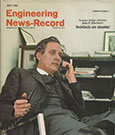John P. Eberhard, known as far back as the mid-1960s for the radical notion that the architect of the future would be a manager of many disciplines—among them engineering, psychology, politics, economics, ecology, art and technology—died May 2 from complications from COVID-19 and congestive heart failure. A pioneer in systems thinking and evidence-based design, he was 93.

“Architects, as conventionally conceived, are obsolete,” Eberhard said in 1969 (ENR 5/8/69 p. 25). “It is no longer sensible to talk about … architects as though they were the only ones involved in architecture.”
That conviction led to the creation in 1968 of the School of Architecture and Environmental Design at the University of Buffalo, with Eberhard as dean. Now named the School of Architecture and Planning at the University at Buffalo, it is the only architecture school in the State University of New York (SUNY) system.
“I have known John for 47 years, have been inspired by his thinking and am proud to work with his legacy at the University at Buffalo,” says Robert G. Shibley, the school's current dean.
“What John started at our school 50 years ago has remained a core value even as we continue to innovate and advance on our approach to systems thinking and evidence-based design," Shibley adds.
Also before his time, Eberhard saw architecture as a clinical science to promote health and increase worker productivity. “This could be a whole new field of science,” he said. As the American Institute of Architects director of research planning, he inspired the Academy of Neuroscience for Architecture. Another example of Eberhard as a change agent was his early 1980s formation of the National Conference of States on Building Codes and Standards. Intent on clearing up confusion around the four model codes, he found funding to start the group while at the National Bureau of Standards.
NCSBCS “may be John’s greatest impact on the building industry,” says Tom Tiedeman, a retired computer expert who was a student and then colleague of Eberhard. “John saw technology as the sum of the ways that people create what they need. He believed that by creating institutions, or changing the ways rules are made, you can change not just a building, but the entire system by which buildings are built.”




Post a comment to this article
Report Abusive Comment